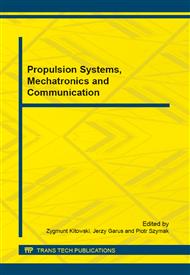[1]
J. van der Geer, J.A.J. Hanraads, R.A. Lupton, The art of writing a scientific article, J. Sci. Commun. 163 (2000) 51-59. Reference to a book.
Google Scholar
[1]
E. Shimizu, E. Pedersen, Y. Takano, Field observation on actual lightering operations, Oceans 2010 IEEE Conference – Sydney, May 2010 1–4.
DOI: 10.1109/oceanssyd.2010.5603641
Google Scholar
[2]
Naval Warfare Publication, Underway Replenishment, Department Of The Navy Office Of The Chief Of Naval Operations, Norfolk (2001).
Google Scholar
[3]
E. Pedersen, E. Shimizu, T. E. Berg, On the Development of Guidance System Design for Ships Operating in Close Proximity, 7052 (2008) 966–971.
DOI: 10.1109/plans.2008.4570039
Google Scholar
[4]
D. Husjord, E. Pedersen, On Guidance and Decision-Support Displays in Ship-to-Ship Lightering Operations, Systems Man and Cybernetics Society, IEEE, eNewsletter, 31 (2010).
Google Scholar
[5]
www. sptmts. com – SPT The Marine Transfer Solution.
Google Scholar
[6]
A. K. Das, R. Fierro, V. Kumar, J. P. Ostrowski, J. Spletzer, C. J. Taylor, A vision-based formation control framework, IEEE Transactions on Robotics and Automation 18(5) (2002) 813–825.
DOI: 10.1109/tra.2002.803463
Google Scholar
[7]
N. Cowant, Vision-based Follow-the-Leader, Proceedings of the 2003 IEEURSJ Intl. Conference on Intelligent Robots and Systems, October 2003, (2003) 1796–1801.
Google Scholar
[8]
A. K. Das, R. Fierro, V. Kumar, B. Southall, J. Spletzer, C. J. Taylor, Real-time vision-based control of a nonholonomic mobile robot, Proceedings 2001 ICRA. IEEE International Conference on Robotics and Automation (Cat. No. 01CH37164), 2 (2001).
DOI: 10.1109/robot.2001.932858
Google Scholar
[9]
A. Waszkiel, Measuring system for parallel moving ships, Polish Maritime Research S1(74) vol. 19 (2012) 66-72.
DOI: 10.2478/v10012-012-0025-3
Google Scholar
[10]
I. F. Ihle, J., Jouffroy, T. I. Fossen, Formation Control of Marine Surface Craft using Lagrange Multipliers, Proceedings of the 44th IEEE Conference on Decision and Control, (2005) 752–758.
DOI: 10.1109/cdc.2005.1582247
Google Scholar
[11]
E. Kyrkjebø, E. Panteley, A. Chaillet, K. Y. Pettersen, A Virtual Vehicle Approach to Underway Replenishment, in Group Coordination and Cooperative Control, Springer, (2006) 171–189.
DOI: 10.1007/11505532_10
Google Scholar
[12]
P. K. C. Wang, Navigation strategies for multiple autonomous robots moving in formation, Journal of Robotic Systems 8(2) (1991) 177–195.
DOI: 10.1002/rob.4620080204
Google Scholar
[13]
Y. Chen, S. Member, Z. Wang, Formation Control : A Review and A New Consideration, 005 IEEE/RSJ International Conference on Intelligent Robots and Systems 435 (2005) 3664–3669.
DOI: 10.1109/iros.2005.1545539
Google Scholar
[14]
S. H. Fu, C. C. Cheng, Nonlinear Adaptive Tracking Control for Underway Replenishment Process Modeling of Two Vessels Tracking with Exogenous Disturbances, Proceedings of the 2004 IEEE International Conference on Networking, Sensing and Control 1 (2004).
DOI: 10.1109/icnsc.2004.1297033
Google Scholar
[15]
S. H. Fu, W. M. Haddad, Nonlinear Adaptive Tracking Of Surface Vessels With Exogenous Disturbances, Asian Journal of Control 5(1) (2008) 88–103.
DOI: 10.1111/j.1934-6093.2003.tb00100.x
Google Scholar
[16]
I. F. Ihle, R. Skjetne, T. I. Fossen, Nonlinear Formation Control of Marine Craft with Experimental Results, 43rd IEEE Conference on Decision and Control Proceedings (2004) 680-685.
DOI: 10.1109/cdc.2004.1428723
Google Scholar
[17]
A. Miller, Ships parallel motion - physical phenomena and their influence on the steering process, mutual position determination methods (pol. Ruch równoległy dwóch jednostek - zjawiska fizyczne i ich wpływ na proces sterowania, sposoby określania wzajemnego położenia statków), Zeszyty Naukowe Akadmii Morskiej w Gdyni 78 (2013).
Google Scholar
[18]
W. Gierusz, Simulation model of the shiphandling training boat Blue Lady, Int. Conf. Control Application in Marine Systems, Glasgow, Scotland, July (2001).
DOI: 10.1016/s1474-6670(17)35092-9
Google Scholar
[19]
Miller A., Model Predictive Control of the ship's motion in presence of wind disturbances, Zeszyty Naukowe, Akademia Morska w Szczecinie, 39(111) (2014) 107-115.
Google Scholar


